Barry Parker
-
- Cruising Beyond Compliance Maritime Logistics Professional, Q1 2014 #16
The global cruise industry quietly takes a prime mover role in maritime scrubber technology. That’s just smart business.
A recent issue of Virtuoso Life, a glossy magazine aimed at upscale travelers, featured a short article highlighting Princess Cruises’ Royal Princess, christened by Duchess Kate Middleton in June, 2013. This article, along with numerous other reviews, highlighted the magnificent atrium, the spa, and the private cabanas. While Princess’s bona fides in shipping’s green camp are well known to shipping people (Princess was an early proponent of cold ironing as far back as 2000; hooking up to shore power at Pacific ports such as Juneau and Seattle), such developments are far removed from the general public – the industry’s customer base.
Two Kinds of Green
Cruise lines, with their voracious appetite for power – feeding both propulsion and hotel load – are also making tremendous, but quiet strides towards energy efficiency. At the same time, restrictions on the sulfur content of fuels are increasing the cost of operations for all manners of global maritime commerce. For example, owners trading within the North American Emission Control Area (ECA) saw a 1percent ceiling on sulfur content imposed in the summer of 2012. In 2015, vessels trading within the ECA will see that ceiling again dropped to 0.1%. Analysts anticipate that the cost differential of low sulfur marine fuel over the high sulfur grade (3.5% maximum since 2012) will increase. And, during December 2013 and January 2014, low sulfur “bunkers” (IFO 180) cost more ($50 to $70/ton) around the U.S. East Coast and, even more ($150 to $195/ton) at U.S. West Coast ports.
The advent of severe restrictions in the ECA’s, a profound business disruptor, has forced the cruise industry to take action. Consider that Carnival Corporation made the news in September 2013, when it announced that it would be spending a reported $180 million on development, partnering with a so far un-named vendor, on a space-saving combination scrubber/particulate filter. Initially, the technology would be deployed on up to 32 vessels trading mainly around North America, including those in Princess and Holland America brands, besides its eponymous Carnival Cruise Line.
Business Models that Make Sense
The Cruise Lines International Association (CLIA) said, in a 2013 position paper: “A one-size-fits-all approach that exclusively requires the use of low sulfur fuel throughout the 200-mile ECA is not the most effective or efficient compliance option allowed under the regulations.” In the cruise industry, therefore, a more creative solution is emerging.
Roger Frizzell, Carnival Corporation’s Chief Communications Officer, told MarPro in February, “We are tremendously excited about the progress we are making with our new and innovative scrubber technology.” Mr. Frizzell also pointed to plans for Carnival’s European brands, adding , “… we are also looking to expand this breakthrough technology to our other brands that are based outside the United States,” mentioning Aida and Costa. He also noted, “Aida, for instance, is one of the early adopters of the scrubbers, with plans to install the technology across its fleet.” Aida, where shorter voyages mean more port time, had announced a €100 million investment program in the summer of 2013. That technology was described as a new, comprehensive filter system that would be deployed on existing and newbuild vessels.
Slimming Bunker Buys with a Heavy Helping of Technology
For 2014, Carnival estimates its overall fuel spending to be a staggering $2.1 billion, based on 3.2 million metric tonnes at an average price of $650/tonne. In regulatory filings from 2013, Carnival had estimated that extra fuel costs, because of ECA’s, would be $265 million in 2015. From the perspective of payback on its scrubber investment, Carnival’s Chief Financial Officer, Mr. David Bernstein, said, on Carnival’s latest investor call, “At this point, it’s fair to say that more than the majority of that $265 million will disappear, so the number will be less than half.” These economics are impressive by any criterion: annual benefits of as much as $130 million on an investment of around $180 million. Moreover, Carnival claims in its latest 10K filing (tied to its 2013 Annual Report), “As a result of installing these scrubbers, we believe the cost of complying with the 2015 ECA sulfur emission requirement will not be significant to our results of operations.” Published reports suggest that Carnival has gained an extra year, to 2016, to achieve implementation. During port calls, the vessels will switch over to shore power, or burn low sulfur fuel. Particulates, trapped in a filter, will be disposed of in port.
Bud Darr, CLIA’s Senior Vice President of Technical and Regulatory Affairs, spoke at length with Maritime Professional about the cruise industry’s proactive and forward-thinking posture regarding emissions. He explained how CLIA’s approach has evolved over the past few years, at a time that the technologies for emissions reduction are evolving rapidly, saying “both operational and technical equivalencies (which could incorporate the use of scrubbers, shore power and alternative fuels, he points out) are of great importance” in considering all viable mechanisms that will achieve emission reduction requirements and goals. He noted that MARPOL ANNEX VI Regulation 4 provides for broad equivalencies. Specifically, the existing text provides that the requirements can be met by any fitting, material, appliance, or apparatus to be fitted in a ship or other procedures, alternative fuel oils, or compliance methods used as an alternative if they are “at least as effective in terms of emission reductions.”
Carnival isn’t alone in the quest for alternative solutions to the emissions quandary. Others have embraced scrubber technology. At RCCL, scrubber technology from Wärtsilä will be deployed on two newbuilds from the Meyer Werft’s Papenburg yard. The 4,200 passenger Quantum of the Seas will debut in November 2014 followed by her sister-ship Anthem of the Seas in April 2015. NCL initially dipped its toe in the water, going with Green Tech Marine’s “GTM-R” equipment on its Pride of America (based in Hawaii) and on its two “Breakaway Plus” newbuilds; the Norwegian Escape and Norwegian Bliss, also with a 4,200 passenger count, coming out of the same Meyer Werft yard, in Q4 2015 and Q2 2017. In mid February, the line also announced that it would be retrofitting six vessels with GTM-R equipment, including Norwegian Breakaway and Norwegian Getaway. NCL explains that: “The GTM-R scrubbers are compact, making it possible for the builds to avoid the loss of cabin space or other service areas. GTM uses one smaller scrubber for each engine instead of a large multi inlet scrubber serving several engines, and the scrubber also replaces the silencer, which is very suitable for cruise ships.”
Distinct Advantages for Early Adaptors
CLIA’s Bud Darr also explained that designers of new builds where scrubbers will be deployed have far more flexibility than those seeking to retrofit scrubbers. He noted that “Cruise ships normally employ medium speed diesel engines that are vertically short in height to fit the allocated machinery space. Space is at a premium, so typically the scrubber will be placed in the stack area,” adding that “sometimes the scrubber can be fitted in the footprint of the silencer.”
In embracing scrubbers, the cruise industry has moved ahead of the overall curve. In DNV GL’s rigorous study “Shipping 2020,” the Class society expresses a view that industry uptake of scrubbers will not be widespread prior to 2020. The possible usage of scrubbers is predicated on the advent of the 0.5% worldwide restrictions on vessels’ sulfur emissions against a backdrop of high fuel prices. And yet, the cruise industry has moved ahead aggressively, nevertheless.
News released by AIDA, the brand within Carnival serving Europe, provides clues as to the technologies that might be deployed in the cruise giant’s company-wide initiative. AIDA explains: “With this as yet unrivaled exhaust treatment technology, we are able to filter and thus reduce by between 90 and 99 percent, all three emissions, namely soot particles, nitrogen oxides, and sulfur oxides, for the very first time.” They add: “This comprehensive filter concept is a milestone for AIDA Cruises, but also for the cruise industry as a whole.”
AIDA also points to the differences in its technology (borrowed from the power generation and automotive spheres). “The system developed within the Carnival Group for treating emissions relies on cutting-edge technology with an especially compact design that is revolutionary because it can technically accommodate all relevant treatment processes. Nitrogen oxides are chemically bound in a catalytic converter and soot and fuel residues are precipitated in a filter. The sulfur oxides are removed in a scrubber without any chemicals being added.”
Maritime Professional’s interview with CLIA’s Darr also provided clues into another aspect of CLIA member companies’ thinking; namely, wash water effluent from scrubbers – something which has caused a great deal of practical concern. He stated that hybrid scrubbers, which provide for both open and closed loop operation, “have a great deal of appeal” to operators of vessels that might be operating near to shore (where a closed loop system might be essential) and then, the next week, operating far out on the ocean where effluent discharge of seawater (used to treat the vessel exhaust) is not problematic.
Since the cruise lines are playing a major role in driving scrubber technology, Mr. Darr’s observations offer guidance well beyond the cruise sector, which has already shown itself to be an early adapter of scrubber technology. In doing so, and strictly in terms of a business strategy, the cruise industry appears to have embarked on a particular course that is designed to both meet and exceed regulatory requirements and preserve, if not fatten the bottom line at the same time. Imagine that: making money in the environmental game. Cruising beyond compliance, indeed.
(As published in the 1Q 2014 edition of Maritime Professional - www.maritimeprofessional.com)
-
- Managing Shipping & Risk with New Variables Maritime Logistics Professional, Q2 2014 #10
Outside investors and other variables change the way that shipping firms manage risk. Investable assets include ships, freight and even the hedging of bunkers. "Shipping is now an investable asset,” was an important observation by analyst Tyler Rosenlicht, a research analyst at investment fund packager
-
- The Economics of Slowing Down Ships Maritime Logistics Professional, Q3 2014 #10
MarPro crunches the numbers on vessel steaming economics. What should you do? It all depends, says Barry Parker … The topics of fuel efficiency, slow steaming and monetary savings have received tremendous attention from all sectors of the maritime business over the past few years. For operators of vessels
-
- Powering Ahead with Wind Assist Technologies Maritime Logistics Professional, Q4 2014 #10
No longer an abstract ‘pie-in-the-sky’ technology, wind assist propulsion could well be a game-changer in the ‘Carbon Wars.’ Wind assist technologies have come of age for shipping companies. A panel discussion entitled “Accelerating Adoption of Double Digit Fuel Saving Technologies,” at the recent Danish
-
- Ship Management and Technology Maritime Logistics Professional, Q1 2015 #50
Technology is central, not merely an add-on, to ship manager brand value. Ship managers who operate vessels on behalf of their owner clients, are the lynchpin of international shipping. As the industry has gone through rounds of relentless cost cutting, at times of increasing regulatory scrutiny
-
- The Other Side of the Flange Maritime Logistics Professional, Q2 2015 #12
Looking beyond the dollars and cents in the demise of bunker giant OW Bunker, MarPro contributor Barry Parker examines the unusual human resources aspect of the story. The old cliché in shipping and commodity businesses says that, “When the tide recedes, you can see which vessels have hulls that are
-
- The Human Aspect of the Autonomous Ship Maritime Logistics Professional, Q3 2015 #14
and whistles that make it float. And if this is indeed the case, the quality of the professionals running it will be even more important. The Author Barry Parker, bdp1 Consulting Ltd. provides strategic and tactical support, including analytics and communications, to businesses across the maritime spectrum
-
- US Boatbuilding: Exports Buoy Bottom Lines Maritime Logistics Professional, Q3 2016 #50
recently advised, “If you are going to play in this market, you better have a lot of patience and significant money to invest.” The Author Barry Parker of bdp1 Consulting Ltd provides strategic and tactical support, including analytics and communications, to businesses across the maritime spectrum
-
- Happy Holidays from Hanjin Maritime Logistics Professional, Q4 2016 #26
Barry Parker dissects one the most disruptive events ever to impact the intermodal supply chain. There is more pain to come, lessons to be learned – and corrections applied. The Hanjin Shipping debacle, brewing over time and seeing a full blown eruption in late August, is still ongoing. The company
-
- LNG: Lagging, Not Gone Marine News, Dec 2016 #30
Low energy prices, depressed day rates and slow growth of bunkering infrastructure has dampened progress for the marine industry’s ‘white knight’ of environmentally friendly fuels. LNG, nevertheless, is here to stay. Slow Start Liquified Natural Gas (LNG) is a clean fuel in abundant supply. The green
-
- North American Ferries: Faster, Greener & Safer Marine News, Jan 2017 #34
up your sleeves. Your ship is about to come in; and there is plenty of room on board for those who want to make journey. All aboard! The Author Barry Parker, bdp1 Consulting Ltd provides strategic and tactical support, including analytics and communications, to businesses across the maritime spectrum
-
- Digging Deep for Good News Maritime Logistics Professional, May/Jun 2017 #15
ships are coming, and further inland, the barges need to move those products to the deepwater gateways. There’s a dredge for that. The Author Barry Parker of bdp1 Consulting Ltd provides strategic and tactical support, including analytics and communications, to businesses across the maritime spectrum
-
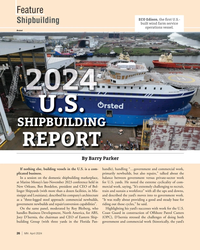 )
April 2024 - Marine News page: 26
)
April 2024 - Marine News page: 26Feature ECO Edison, the ? rst U.S.- Shipbuilding built wind farm service operations vessel. Ørsted U.S. SHIPBUILDING REPORT By Barry Parker If nothing else, building vessels in the U.S. is a com- handle), handling “…government and commercial work, plicated business. primarily newbuilds, but also
-
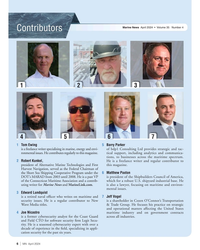 )
April 2024 - Marine News page: 6
)
April 2024 - Marine News page: 6Marine News April 2024 • Volume 35 Number 4 Contributors 1 2 3 5 4 6 7 1 Tom Ewing 5 Barry Parker is a freelance writer specializing in marine, energy and envi- of bdp1 Consulting Ltd provides strategic and tac- ronmental issues. He contributes regularly to this magazine. tical support, including
-
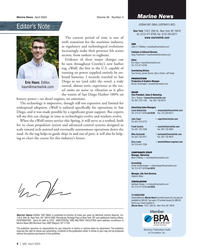 )
April 2024 - Marine News page: 4
)
April 2024 - Marine News page: 4212-477-6700 tug, eWolf, the ? rst in the U.S. capable of Contributing Writers running on power supplied entirely by on- Tom Ewing, James Kearns, Barry Parker, Jeff Vogel board batteries. I recently traveled to San PRODUCTION Production & Graphics Manager Diego to see (and ride) the vessel, a
-
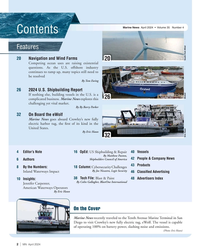 )
April 2024 - Marine News page: 2
)
April 2024 - Marine News page: 2Report If nothing else, building vessels in the U.S. is a 26 complicated business. Marine News explores this challenging yet vital market. By By Barry Parker 32 On Board the eWolf Marine News goes aboard Crowley’s new fully electric harbor tug, the ? rst of its kind in the United States. By Eric
-
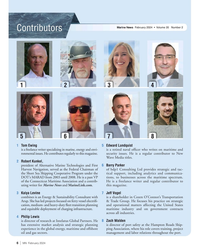 )
February 2024 - Marine News page: 6
)
February 2024 - Marine News page: 6issues. He is a regular contributor to New Wave Media titles. 2 Robert Kunkel, president of Alternative Marine Technologies and First 6 Barry Parker Harvest Navigation, served as the Federal Chairman of of bdp1 Consulting Ltd provides strategic and tac- the Short Sea Shipping Cooperative Program
-
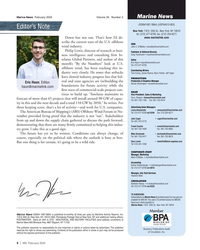 )
February 2024 - Marine News page: 4
)
February 2024 - Marine News page: 4. Tel: 212-477-6700 offshore wind, has been tracking this in- Contributing Writers dustry very closely. He notes that setbacks Tom Ewing, James Kearns, Barry Parker, Jeff Vogel have slowed industry progress but that fed- PRODUCTION Production & Graphics Manager eral and state agencies are (re)building
-
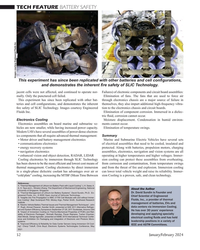 )
January 2024 - Marine Technology Reporter page: 52
)
January 2024 - Marine Technology Reporter page: 52TECH FEATURE BATTERY SAFETY Images courtesy Engineered Fluids Inc. This experiment has since been replicated with other batteries and cell con? gurations, and demonstrates the inherent ? re safety of SLIC Technology. jacent cells were not affected, and continued to operate nor- Failures) of electronic
-
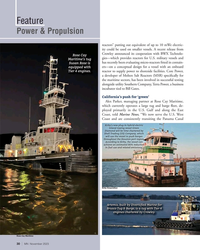 )
November 2023 - Marine News page: 30
)
November 2023 - Marine News page: 30Feature Power & Propulsion reactors” putting out equivalent of up to 10 mWe electric- ity could be used on smaller vessels. A recent release from Crowley announced its cooperation with BWX Technolo- Rose Cay Rose Cay gies—which provides reactors for U.S. military vessels and Maritime’s tug Maritime’s
-
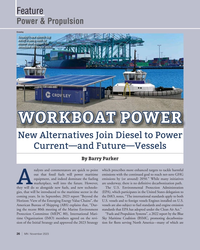 )
November 2023 - Marine News page: 26
)
November 2023 - Marine News page: 26Boat Builders for scheduled delivery in 2024. WORKBOAT POWERWORKBOAT POWER New Alternatives Join Diesel to Power Current—and Future—Vessels By Barry Parker nalysts and commentators are quick to point which prescribes more enhanced targets to tackle harmful out that fossil fuels will power maritime
-
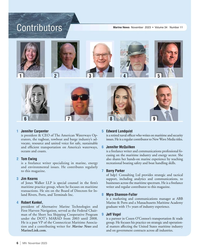 )
November 2023 - Marine News page: 6
)
November 2023 - Marine News page: 6in marine, energy recreational boating safety and boat handling skills. and environmental issues. He contributes regularly to this magazine. 7 Barry Parker of bdp1 Consulting Ltd provides strategic and tactical 3 Jim Kearns support, including analytics and communications, to of Jones Walker
-
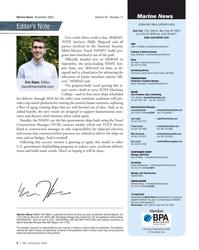 )
November 2023 - Marine News page: 4
)
November 2023 - Marine News page: 4212-477-6700 pire State, was “delivered on time, as de- Contributing Writers signed and at a ? xed price for advancing the Tom Ewing, James Kearns, Barry Parker, Jeff Vogel education of future merchant marine of? - PRODUCTION Production & Graphics Manager cers,” MARAD said. Eric Haun, Editor, Nicole
-
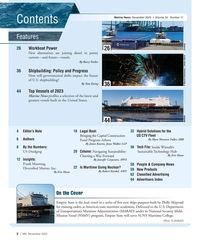 )
November 2023 - Marine News page: 2
)
November 2023 - Marine News page: 22023 • Volume 34 Number 11 Contents Features 26 Workboat Power 26 New alternatives are joining diesel to power current—and future—vessels. By Barry Parker 36 Shipbuilding: Policy and Progress How will governmental shifts impact the future of U.S. shipbuilding? By Tom Ewing 36 44 Top Vessels of
-
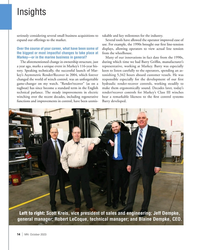 )
October 2023 - Marine News page: 14
)
October 2023 - Marine News page: 14in general? Many of our innovations in fact date from the 1990s, The aforementioned change in ownership structure, just during which time we had Barry Grif? n, manufacturer’s a year ago, marks a unique event in Markey’s 116-year his- representative, working at Markey. Barry was especially tory
-
 )
October 2023 - Marine News page: 6
)
October 2023 - Marine News page: 6. (NOIA), a trade group representing America’s offshore energy industry. 4 Jim Kearns of Jones Walker LLP is special counsel in the ? rm’s 9 Barry Parker maritime practice group, where he focuses on maritime of bdp1 Consulting Ltd provides strategic and tactical transactions. He sits on the Board
-
 )
October 2023 - Marine News page: 4
)
October 2023 - Marine News page: 4.com Tel: 212-477-6700 • Biden’s Offshore Wind Target Slipping Out of Reach as Projects Struggle Contributing Writers Tom Ewing, James Kearns, Barry Parker, Jeff Vogel • BOEM Postpones Oil and Gas Lease PRODUCTION Sale 261 Production & Graphics Manager Eric Haun, Editor, Nicole Ventimiglia
-
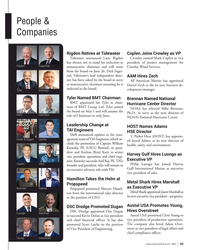 )
June 2023 - Marine News page: 43
)
June 2023 - Marine News page: 43People & Companies Rigdon Retires at Tidewater Coplen Joins Crowley as VP Tidewater announced Larry Rigdon Crowley named Mark Coplen as vice has chosen not to stand for reelection as president of project management for Rigdon Fagerstal nonexecutive chairman and will retire Crowley Wind Services. from
-
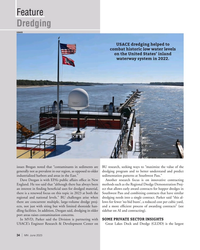 )
June 2023 - Marine News page: 34
)
June 2023 - Marine News page: 34Feature Dredging USACE USACE dredging helped to combat historic low water levels on the United States’ inland waterway system in 2022. issues Brogan noted that “contaminants in sediments are BU research, seeking ways to “maximize the value of the generally not as prevalent in our region, as opposed
-
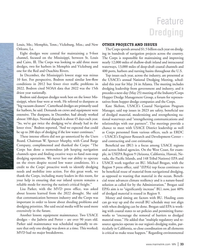 )
June 2023 - Marine News page: 33
)
June 2023 - Marine News page: 33Feature Dredging Louis, Mo.; Memphis, Tenn.; Vicksburg, Miss.; and New OTHER PROJECTS AND ISSUES Orleans, La. The Corps spends around $1.5 billion each year on dredg- Eight dredges were central for maintaining a 9-foot ing in hundreds of navigation projects across the country. channel, focused on the
-
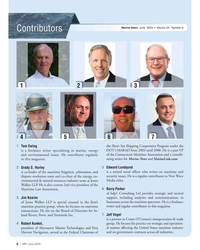 )
June 2023 - Marine News page: 6
)
June 2023 - Marine News page: 6& natural resources industry team at Jones Media titles. Walker LLP. He is also current 2nd vice president of the Maritime Law Association. 6 Barry Parker of bdp1 Consulting Ltd provides strategic and tactical 3 Jim Kearns support, including analytics and communications, to of Jones Walker
-
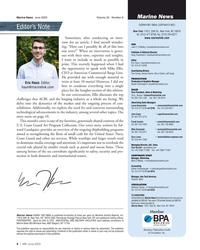 )
June 2023 - Marine News page: 4
)
June 2023 - Marine News page: 4had Tel: 212-477-6700 the opportunity to speak with Mike Ellis, Contributing Writers CEO at American Commercial Barge Line. Tom Ewing, James Kearns, Barry Parker, Jeff Vogel He provided me with enough material to PRODUCTION Production & Graphics Manager write at least 10 stories! However, I did
-
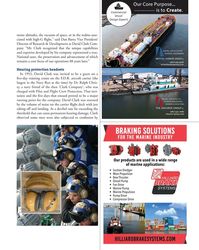 )
August 2023 - Marine News page: 25
)
August 2023 - Marine News page: 25treme altitudes, the vacuum of space, or in the realms asso- ciated with high-G ? ight,” said Dan Barry, Vice President/ Director of Research & Development at David Clark Com- pany. “Mr. Clark recognized that the unique capabilities and expertise developed by his company represented a true, National asset
-
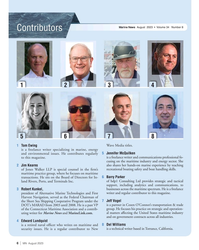 )
August 2023 - Marine News page: 6
)
August 2023 - Marine News page: 6safety and boat handling skills. maritime practice group, where he focuses on maritime transactions. He sits on the Board of Directors for In- 6 Barry Parker land Rivers, Ports, and Terminals Inc. of bdp1 Consulting Ltd provides strategic and tactical support, including analytics and communications
-
 )
August 2023 - Marine News page: 4
)
August 2023 - Marine News page: 4212-477-6700 shortages. And we cannot overlook the hu- Contributing Writers man aspect of this trade; behind every vessel Tom Ewing, James Kearns, Barry Parker, Jeff Vogel exists countless stories of individuals whose PRODUCTION Production & Graphics Manager hard work breathes life into steel
-
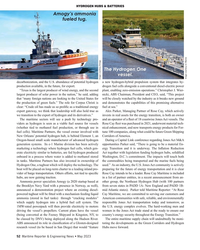 )
May 2023 - Maritime Reporter and Engineering News page: 52
)
May 2023 - Maritime Reporter and Engineering News page: 52HYDROGEN HUBS & BATTERIES Amogy’s ammonia fueled tug. The Hydrogen One vessel. Image courtesy e1 Marine Image courtesy Amogy decarbonization, and the U.S. abundance of potential hydrogen a new hydrogen-hybrid propulsion system that integrates hy- production available, in the future, for export. drogen
